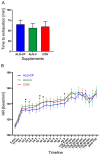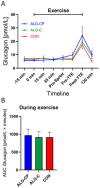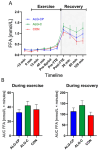The Effect of Ingesting Alginate-Encapsulated Carbohydrates and Branched-Chain Amino Acids During Exercise on Performance, Gastrointestinal Symptoms, and Dental Health in Athletes
- PMID: 39771033
- PMCID: PMC11676411
- DOI: 10.3390/nu16244412
The Effect of Ingesting Alginate-Encapsulated Carbohydrates and Branched-Chain Amino Acids During Exercise on Performance, Gastrointestinal Symptoms, and Dental Health in Athletes
Abstract
Background: This study aimed to compare the effects of a carbohydrate (CHO) hydrogel with (ALG-CP) or without (ALG-C) branched-chain amino acids, and a CHO-only non-hydrogel (CON), on cycling performance. The hydrogels, encapsulated in an alginate matrix, are designed to control CHO release, potentially optimising absorption, increasing substrate utilisation, and reducing gastrointestinal distress as well as carious lesions.
Methods: In a randomised, double-blinded, crossover trial, 10 trained male cyclists/triathletes completed three experimental days separated by ~6 days. During the experimental days, participants completed a standardised 2 h cycling bout (EX1), followed by a time-to-exhaustion (TTE) performance test at W75%. Supplements were ingested during EX1.
Results: Participants cycled ~8.8 (29.6%) and ~5.4 (29.1%) minutes longer during TTE with ALG-CP compared to ALG-C and CON, respectively. TTE was 65.28 ± 2.8 min with ALG-CP, 56.46 ± 10.92 min with ALG-C, and 59.89 ± 11.89 min with CON. Heart rate (HR) was lower during EX1 with ALG-CP (p = 0.03), and insulin levels increased more significantly during the first 45 min with ALG-CP. Plasma glucose and glucagon levels remained consistent across supplements, although glucagon was higher with ALG-CP before TTE. Post-exercise myoglobin levels were lower with ALG-CP compared to ALG-C (p = 0.02), indicating reduced muscle damage.
Conclusions: While ALG-CP improved performance duration compared to ALG-C and CON, the difference did not reach statistical significance. Additionally, there was a lower HR during the cycling session, alongside a significantly lower level of myoglobin with ALG-CP. These findings suggest that ALG-CP may offer advantages in cycling performance and recovery.
Keywords: BCAA; TTE; alginate; athletic performance; carbohydrates; dental health; gastrointestinal comfort; hydrogels; recovery.
Conflict of interest statement
The authors declare no conflicts of interest. The funders had no role in the design of the study; in the collection, analyses, or interpretation of data; in the writing of the manuscript; or in the decision to publish the results.
Figures










Similar articles
-
The Effect of Alginate Encapsulated Plant-Based Carbohydrate and Protein Supplementation on Recovery and Subsequent Performance in Athletes.Nutrients. 2024 Jan 31;16(3):413. doi: 10.3390/nu16030413. Nutrients. 2024. PMID: 38337697 Free PMC article. Clinical Trial.
-
Addition of sodium alginate and pectin to a carbohydrate-electrolyte solution does not influence substrate oxidation, gastrointestinal comfort, or cycling performance.Appl Physiol Nutr Metab. 2020 Jun;45(6):675-678. doi: 10.1139/apnm-2019-0802. Epub 2020 Jan 22. Appl Physiol Nutr Metab. 2020. PMID: 31967853
-
Intake of Protein Plus Carbohydrate during the First Two Hours after Exhaustive Cycling Improves Performance the following Day.PLoS One. 2016 Apr 14;11(4):e0153229. doi: 10.1371/journal.pone.0153229. eCollection 2016. PLoS One. 2016. PMID: 27078151 Free PMC article. Clinical Trial.
-
The Effect of Ingesting Carbohydrate and Proteins on Athletic Performance: A Systematic Review and Meta-Analysis of Randomized Controlled Trials.Nutrients. 2020 May 20;12(5):1483. doi: 10.3390/nu12051483. Nutrients. 2020. PMID: 32443678 Free PMC article.
-
Carbohydrate Hydrogel Products Do Not Improve Performance or Gastrointestinal Distress During Moderate-Intensity Endurance Exercise.Int J Sport Nutr Exerc Metab. 2020 Sep 1;30(5):305-314. doi: 10.1123/ijsnem.2020-0102. Epub 2020 Jul 23. Int J Sport Nutr Exerc Metab. 2020. PMID: 32707564 Review.
References
Publication types
MeSH terms
Substances
Grants and funding
LinkOut - more resources
Full Text Sources
Medical
Miscellaneous

